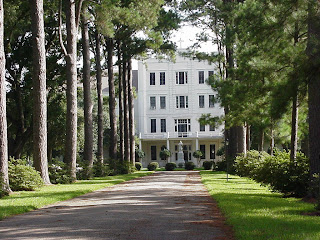Grand Coteau, one of the few rural districts on the National Register of Historic Places, is one of eight new Cultural Districts in the state of Louisiana. Approved by the Department of Culture, Recreation and Tourism, Cultural Districts allow designated property owners to apply for state historic tax credits for
 |
| Antique shop in Grand Coteau |
renovation projects. Sales of original works of art in the districts are tax exempt.
Grand Coteau joins Eunice and Arnaudville as other Cultural Districts in St. Landry Parish. As of July 1, there are now 59 districts in 34 towns and 24 parishes across the state.
In addition to Grand Coteau, other recently approved districts include the Highland Community in Shreveport, Denham Springs, Donaldsonville, Downtown DeRidder, Breaux Bridge, Ascension Parish and Old South Baton Rouge.
Patrice Melnick, an arts events organizer and gift shop owner in Grand Coteau, says the Cultural District designation is a big boost for the town.
"This designation will help to highlight the arts in Grand Coteau including literary, visual and performing," said Melnick. "Grand Coteau is home to musicians Jude Taylor and Curly Taylor, to quilt maker Gwendolyn Miller and recylce artist Trish Ransom. And the Festival of Words and other literary events are flourishing.
“As a merchant, I appreciate the opportunity to highlight hand-made, original art, and the tax-free benefit will certainly catch the attention of tourists and local shoppers." Grand Coteau rests on a ridge that was once the west bank of the Mississippi River some 2,000 years ago. Established as a town in 1821, Grand Coteau became a home of Acadian, Creole, Irish and German immigrants.
The town has more than 70 structures designated as architecturally significant of the historic cultures that settled the region. Grand Coteau and Catholicism share a history of nearly 200 years through the Academy of the Sacred Heart, established in 1821, and St. Charles College, a Jesuit boarding school founded in 1837.
Many historic buildings are surrounded by age-old oak trees that form alleys, groves and gardens. Antiques and art shops and studios abound throughout the town.
“For our 102-year-old building, we will be able to do renovations with assistance from the state of Louisiana,” said Greg Thibodeaux, business manager at St. Charles College.
 |
| St. Charles College |
As a Cultural District, Grand Coteau can use its designation to attract people, businesses, renovations and cultural activities. The state law provides two targeted tax incentives for cultural districts: (1) the rehabilitation of older buildings may qualify for state historic tax credits and (2) the sale of original, one-of-a-kind qualifying works of art are exempt from state and local sales tax.
The 2010 Cultural Districts Annual Report supports the premise that by incentivizing cultural development, a community diversifies and develops new economic opportunities. In 2010, the existing 51 districts boast 777 cultural assets and hosted 548 events in 2010 that served approximately 3.5 million people.
A total of 783 new businesses opened within the boundaries of cultural districts during 2010. Of those, 191 were art/cultural businesses.
Factoring in businesses that closed during the same period in these districts targeted for cultural development, the percentage of art and cultural businesses increased by 35%.
The Louisiana Cultural District program is a model recognized by the National Association of State Arts Agencies and featured in the Mayors' Institute on City Design's (MICD) most recent publication, Creative Placemaking. Louisiana takes pride in our Cultural District hubs of cultural development.
For more information on the state’s Cultural District Program, visit www.crt.la.us/culturaldistricts.
No comments:
Post a Comment